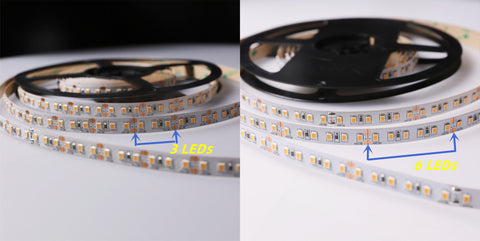
12V vs 24V LED Strip: What is the difference and which one to choose?
When we are looking for LED strips, the priority is generally light color, light intensity and length. Voltage is often overlooked, although this is also an important characteristic of LED strips. 12V and 24V are the most common options and are everywhere in the market. This article will tell you their differences and give you some guidance on your purchase.
I: What is the Difference Between 12V and 24V LED Strip Lights?
1.Power supply option
None of the LED strips will light up without a power supply. Power supplies are available in different versions, such as modular power supplies, flat power supplies, waterproof hermetic power supplies, desktop power supplies, etc. These power supplies are available in both 12V and 24V versions for LED strip installation, but in comparison, 12V power supplies on the market have more options and are easier to find than 24V ones.
Pay attention to the power supply capacity when choosing your power supply. It needs to be greater than the power consumption of the LED strip to avoid overheating and prolong the life of the power supply. In addition, never connect a 12V LED strip to a 24V DC power supply as it will burn out the light.
YUJILEDS is supplying a 120W IP67waterproof hermetic power supply, which offers 12V and 24V versions.
2.Cut point
Each LED strip light is made by joining or linking a plurality of the smallest cuttable circuit units. The minimum cuttable unit is called as cutting increment. With the same LED density, the length of cutting increment for a 12V LED strip light is often half to that of a 24V LED strip light.
For instance, YUJI 2835 LED strip with a density of 120LEDs per meter, has the cutting increment of 50mm for the 24V version, and of 25mm for the 12V version.
Each LED strip has cutting points, but they vary by LED strip, some of the strips can be cut every 6 LEDs, some can be cut every 3 LEDs, YUJI dim to warm LED strip can be cut every 12 LEDs and YUJI 2835M LED strip can be cut every 8 LEDs. Cut points are labelled as the image shows below. Make sure to only cut the strip at the cut point, otherwise the connection will be damaged and the strip will not light up.

3.Brightness
Whether you are using a 12 V LED light strip or 24V LED strip light, there is no obvious difference in brightness. However, because of the voltage drop, a 24V LED strip light performs at higher efficiency with similar brightness.
4.Voltage drop
As the circuit gets longer, the resistance of the wiring and components causes the voltage to slowly decrease away from the power source. This means that at the end of the run, the voltage will be significantly lower than it was at the beginning. If the LED strip is installed beyond its specified maximum run length, the lights will start to flicker or dim and the overall performance will drop significantly.
While there are many factors that affect voltage drop, LED strip density and voltage are the most direct variables. The higher the LED density of the strip is, the shorter the maximum run time will be (assuming all other things being equal). Voltage also directly affects the max run of an LED strip. At the same power and density, higher voltage bars will have lower current draw, which allows higher voltage LED strips to have longer maximum run times.
5.Luminous efficiency
Among these two forms of low voltage LED strips, 24V LED strip light has higher luminous efficiency as compared to 12V strip. Typically, LED strip circuits have resistance and generate heat. The heat dissipated is part of wasted energy. If both strips have the same wattage, the strip that consumes less heat will be more luminous because it can use more power to emit light.
With the same LED density, length, and wattage, a 12V LED strip will consume twice as much current as a 24V LED strip. For example, the YUJI 2835 LED light has a length of 5m, 120 LEDs per meter, and the power is 90W. The current with the 12V version is 90W/12V = 7.5A, while the 24V version is 90W/24V = 3.75A.
The higher the current, the more heat the circuit generates, the more energy is wasted in the form of thermal energy, and the less energy is used to emit light. Therefore, the luminous efficiency of 12V LED strip is lower than that of 24V.
Ⅱ.Which One to Choose, 12V or 24V?

The difference between 12V LED strip and 24V LED strip is insignificant in some cases. For small installations that require a 12V battery, a 12V LED strip is recommended. But for larger projects, we suggest you consider 24V LED strips. We also think the 24V would be better than 12V if power supply selection and cuttable length are not important considerations for you.
YUJILEDS offers 12V high CRI led strips and 24V high CRI led strips. They have the same number of LEDs, the same power and light output, just different voltage and amperage combination. However, 24V LED strips will generally perform better as the 24V version draws less amperage as described above.
One more, if you need a longer line of light from one power supply, a 24 VDC LED strip is a good choice. While higher voltages do not mean a brighter light, 24 VDC is also capable of sustaining higher density LED chips.
Feel free to contact us if you still have questions on choosing LED strips.

Leave a comment